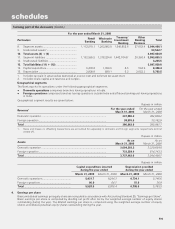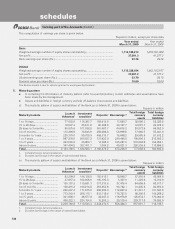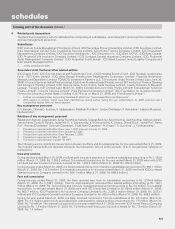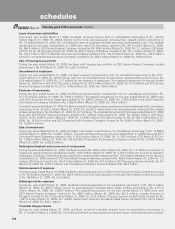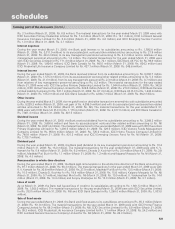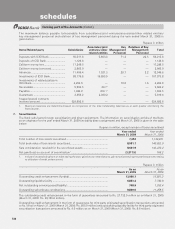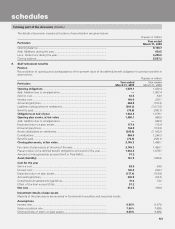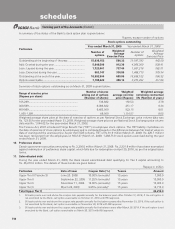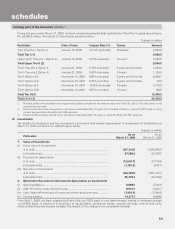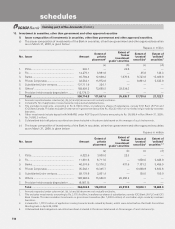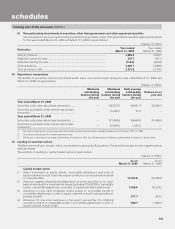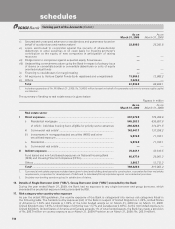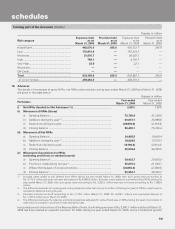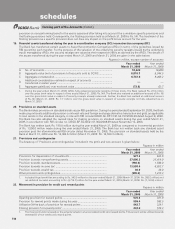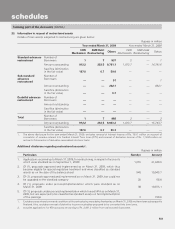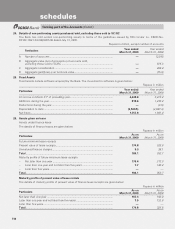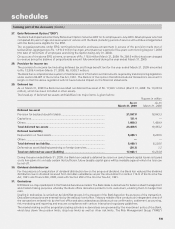ICICI Bank 2009 Annual Report Download - page 103
Download and view the complete annual report
Please find page 103 of the 2009 ICICI Bank annual report below. You can navigate through the pages in the report by either clicking on the pages listed below, or by using the keyword search tool below to find specific information within the annual report.
F29
Particulars Year ended
March 31, 2009 Year ended
March 31, 2008
Investment details of plan assets
Majority of the plan assets are invested in insurer managed funds and special deposit schemes.
Assumptions
Interest rate ........................................................................................................... 6.85% 8.57%
Salary escalation rate ............................................................................................ 7.00% 7.00%
Estimated rate of return on plan assets ............................................................... 8.00% 8.00%
Experience adjustment Rupees in million
Particulars Year ended
March 31, 2009 Year ended
March 31, 2008 Year ended
March 31, 2007
Plan assets ..................................................................................... 2,272.1 1,506.7 891.7
Defined benefit obligations ............................................................ 2,195.7 1,840.4 1,142.1
Amount not recognised as an asset (limit in para 59(b)) ............... 7.9 ——
Surplus/(deficit) .............................................................................. 68.5 (333.7) (250.4)
Experience adjustment on plan assets .......................................... (118.0) (24.8) (18.0)
Experience adjustment on plan liabilities ...................................... (4.1) 14.0 38.1
The estimates of future salary increases, considered in actuarial valuation, take into consideration inflation, seniority,
promotion and other relevant factors.
The guidance on implementing Accounting Standard 15, Employee Benefits (revised 2005) issued by the Accounting
Standards Board (ASB) provides that exempt provident funds which require employers to meet the interest shortfall are in
effect defined benefit plans. The Bank’s actuary has informed that it is not practicable to actuarially determine the interest
shortfall obligation.
9. Employee Stock Option Scheme (“ESOS”)
In terms of the ESOS, as amended, the maximum number of options granted to any eligible employee in a financial year
shall not exceed 0.05% of the issued equity shares of the Bank at the time of grant of the options and aggregate of all
such options granted to the eligible employees shall not exceed 5% of the aggregate number of the issued equity shares
of the Bank on the date(s) of the grant of options. Under the stock option scheme, options vest in a graded manner over a
four-year period, with 20%, 20%, 30% and 30% of grants vesting each year, commencing from the end of 12 months
from the date of grant. The options can be exercised within 10 years from the date of grant or five years from the date of
vesting, whichever is later.
In terms of the Scheme, 18,992,504 options (March 31, 2008: 15,638,152 options) granted to eligible employees were
outstanding as at March 31, 2009.
As per the scheme, the exercise price of ICICI Bank’s options is the last closing price on the stock exchange, which recorded
highest trading volume preceding the date of grant of options. Hence, there is no compensation cost in the year ended
March 31, 2009 based on intrinsic value of options. However, if ICICI Bank had used the fair value of options based on the
Black-Scholes model, compensation cost for the year ended March 31, 2009 would have been higher by Rs. 1,411.7 million
and proforma profit after tax would have been Rs. 36,169.6 million. On a proforma basis, ICICI Bank’s basic and diluted
earnings per share would have been Rs. 32.49 and Rs. 32.43 respectively. The key assumptions used to estimate the fair
value of options granted during the year ended March 31, 2009 are given below:
Risk-free interest rate ...................................................................................... 7.62% to 9.24%
Expected life ................................................................................................... 2 – 6.4 years
Expected volatility ........................................................................................... 38.90% to 45.23%
Expected dividend yield .................................................................................. 1.20% to 3.57%
The weighted average fair value of options granted during the year ended March 31, 2009 is Rs. 331.19.
forming part of the Accounts (Contd.)
schedules


